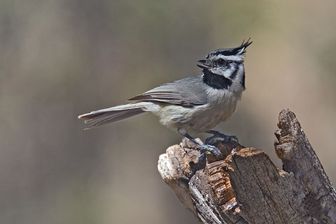Bridled Titmouse
These birds have grey upperparts and white underparts with a white face with black striping, a grey crest, a black throat, and a short stout bill.

The Bridled Titmouse is classified as Least Concern. Does not qualify for a more at risk category. Widespread and abundant taxa are included in this category.
The Bridled Titmouse is well named for its striking facial pattern, which in combination with a crest distinguishes it from all other North American species of titmice and chickadees. Originally described by Charles Bonaparte, the species was named for Wollweber, who supposedly collected a specimen in Mexico before 1850; Wollweber’s role remains mysterious, however, because museum archives lack any information concerning him (Mearns and Mearns 1992). More
The Bridled Titmouse, Baeolophus wollweberi, is a small songbird, a passerine bird in the tit family Paridae. These birds have grey upperparts and white underparts with a white face with black striping, a grey crest, a black throat, and a short stout bill. More
Bridled Titmouse: Five to seven white eggs are laid in a nest made of moss, lined with animal fur, feathers, and shredded bark, and built from 4 to 8 feet above the ground in a conifer, deciduous tree, nest box, or snag. Female incubates eggs for about 14 days. Foraging and Feeding Bridled Titmouse: Eats insects, pine seeds, acorns, and other seeds. Gleans insects from leaves and twigs, often hanging upside down; holds food under feet for pecking. Often forages in mixed species flocks. More
Only the Bridled Titmouse has a bib. genders are similar. Titmice often flock with chickadees, warblers and kinglets, except in the nesting season. More
* The Bridled Titmouse is the smallest North American titmouse. * Though populations appear to be steady, its limited distribution in the U.S. combined with future habitat destruction could cause problems. Destruction of oak woodlands in Mexico has caused its extirpation in some historic breeding regions. * Unlike the other titmice species, they do not hide seeds for future use. More
Bridled Titmouse, the Southernmost Species of Bird of the Baeolophus Genus The Bridled Titmouse (Baeolophus wollweberi) averages about 5.25 inches in length. It has a blue gray back, tail, and blue-gray wings, with slightly lighter undersides. On its face there is a series of black lines that give it a bridled appearance, making this small titmouse easily distinguishable from other species. The Bridled Titmouse is found in parts of Arizona, New Mexico, and in much of Mexico. More
Bridled Titmouse has a black bib and a white-and-black patterned face. Primarily a Mexican species, its range reaches the United States only in the southern mountains of Arizona and New Mexico. More
Bridled Titmouse has black markings on its head, and a pale belly. However, most American bird watchers will have to take a bird watching tour to identify this bird as it only lives in the south of Arizona and New Mexico. More
bridled titmouse is the only tit species to have a helper breeding system. CONSERVATION STATUS A species with a restricted range, but common within this range, reaching densities of 7.7–10.3 birds/25 acres (10 ha) in summer. Loss and fragmentation of oak woodlands due to conversion to arable land known to have caused decline in central Mexico. SIGNIFICANCE TO HUMANS None known. More
The Bridled Titmouse lives in the mountainous ranges of Mexico. In the United States, it is restricted to mountains of southeastern Arizona and southwestern New Mexico, where it lives at elevations from 1,800 to 2,150 meters. It breeds mostly in oak or mixed oak-pine-juniper woodlands in the United States and occurs in oak and oak-pine woodlands in Mexico. Some populations move to riparian corridors during winter. Though populations appear to be steady, its limited distribution in the U.S. More
The range of the Bridled Titmouse overlaps that of the Mountain Chickadee, but the unique face pattern and crest distinguish this species. It accepts nesting holes made or used by other species and even settles in breeding boxes. NESTING 5-7 white eggs in a tree hole. More
The Bridled Titmouse is a year-round resident from central and southeastern Arizona and southwestern New Mexico, south locally to Mexico. This species of titmouse is enerally found in oak woodlands and pine-oak associations from 5,000 to 7,000 feet in elevation. In winter, it may move down slope along streams where cottonwoods are present. The Bridled Titmouse usually builds a nest in natural cavities of dead and living oak, but will also use cavities in cottonwood, willow, and mesquite. More
here was taken of a Bridled Titmouse in the mountains above Teotitlan del Valle, Oaxaca, Mexico, in March, 1993, with a Canon T90 and a 400mm F/4.5 lens on Kodachrome 200. 305 Loganberry Ct. More
Bridled Titmouse is a woodland species of the Mexican Plateau, with limited distribution in New Mexico and Arizona. The New Mexico population is limited to pine-oak and riparian habitats in the southwest portion of the state. It is not considered threatened, but its limited distribution and dependence on a just a few habitat types make it a species that should be monitored. More
Bridled Titmouse, The Drip At Madera Canyon, Near Green Valley, Arizona Photograph by Alan And Elaine Wilson. Some rights reserved. BRIDLED TITMOUSE FACTS - - Description The Bridled Titmouse is a small gray bird with small black and gray crest. More
Family : Paridae
Genus : Baeolophus
Species : wollweberi
Authority : (Bonaparte, 1850)

